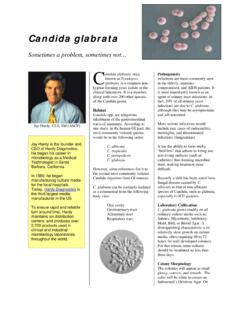Transcription of Harmless Diphtheroids or Dangerous Pathogen?
1 Harmless Diphtheroids or Dangerous Pathogen? Can You Identify This Organism? An elderly gentleman presented at a community hospital emergency room with symptoms of hematuria and a history of urologic problems. Among other tests, two sets of blood cultures were drawn and taken to the microbiology laboratory for incubation in their automated blood culture detection system. Both the aerobic and the anaerobic bottles of each set were flagged as positive within 36 hours of incubation. Samples from the bottles were Gram stained and sub-cultured to a Blood Agar, Chocolate Agar, and a MacConkey Agar plate (all incubated at 35-37 deg. C. at 5-10% CO2); and a Brucella Agar and BBE/LKV plate (incubated anaerobically). A Gram stain of all bottles showed small pleomorphic Gram positive rods resembling Diphtheroids . Subcultures were examined at 24 hours. No growth was seen on the aerobic subs and pinpoint growth was observed on the anaerobic Brucella Agar plate.
2 At 48 hours, pinpoint growth was seen on the aerobic Blood and Chocolate plates. At 72 hours, the plates showed small non-hemolytic colonies that were catalase positive, Gram positive pleomorphic rods resembling Diphtheroids in their morphology. A definitive rapid commercial kit identification was performed and an ID of 99% was reached after 4 hours. Hint: the test results included a positive urea. Colonies on Blood Agar at 48 hours. Gram stain Answer and Discussion The organism was identified as Corynebacterium urealyticum. Corynebacteria, from the Greek words koryne meaning club, and bacterion, meaning little rod, are catalase positive, aerobic or facultatively anaerobic, generally non-motile Gram positive rods. C. diphtheriae and the non-diphtherial corynebacteria known as Diphtheroids comprise the genus. Diphtheroids have traditionally been considered part of the normal commensal flora of the skin and mucous membranes of the respiratory tract, urinary tract and conjuctiva.
3 In fact, about 12-30% of humans carry C. urealyticum as part of their normal skin flora. However, more recent data shows that Diphtheroids , including C. urealyticum (previously known as CDC group d2), C. jeikeium, and C. striatum, can be the eti ologic agents of disease in the very young or the elderly, the immunosuppressed or immunocompromised, or those having abnormalities or manipulations of the urinary or respiratory tract. Domestic animals such as cats and dogs as well as a variety of farm animals can also be infected. Diphtheroids are ubiquitous in nature, found in soil, water, plants and food products. Given this ubiquity in both nature and animals, it is not surprising that C. urealyticum and other Diphtheroids can be isolated as pathogens if they are tested for and identified in suspect sites and patient populations. Microbiologically, C. urealyticum is a non-hemolytic, rapid urea positive, catalase positive, non-spore forming small slender Gram positive rod.
4 It exhibits a tendency towards pleomorphism and tends to remain attached at odd angles giving it the palisading or Chinese letter Gram stain morphology. It produces small colonies on simple media such as BAP or TSA. C. urealyticum may be found in cases of UTI, bacteremia, endocarditis, pneumonia, peritonitis, or osteomyelitis. When Diphtheroids (Gram stained and catalase tested) are isolated in either pure culture or significant amounts from either urine or sterile sites, they should not be dismissed as normal flora or contaminants, but rather worked up to at least rule in or out C. urealyticum or other possible pathogenic Diphtheroids . Treatment of C. urealyticum may be challenging as it is intrinsically highly resistant and may require susceptibility testing for optimal results. Generally, it has been shown to be resistant to the penicillins and variably susceptible to the fluoroquinolones.
5 Vancomycin remains the drug of choice for treatment. In summary, C. urealyticum and other Diphtheroids may be under reported as etiologic agents of disease for a number of reasons, including poor or slow growth on solid media, and not realizing that they may indeed be pathogens . As PCR infectious disease testing becomes more widely utilized and includes a broader organism base, identification of pathogenic Diphtheroids should be enhanced. Until that time, the use of rapid biochemical tubed media or commercial test kits are available for work up. Barbara L. Fox, MS, MPH, MT (ASCP), CLS Microbiologist Lodi Memorial Hospital Lodi, California


